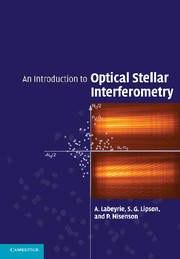Book contents
- Frontmatter
- Contents
- List of Illustrations
- Preface
- Peter Nisenson, 1941–2004
- 1 Introduction
- 2 Basic concepts: a qualitative introduction
- 3 Interference, diffraction and coherence
- 4 Aperture synthesis
- 5 Optical effects of the atmosphere
- 6 Single-aperture techniques
- 7 Intensity interferometry
- 8 Amplitude interferometry: techniques and instruments
- 9 The hypertelescope
- 10 Nulling and coronagraphy
- 11 A sampling of interferometric science
- 12 Future ground and space projects
- Appendix A
- Appendix B
- Index
11 - A sampling of interferometric science
Published online by Cambridge University Press: 23 February 2010
- Frontmatter
- Contents
- List of Illustrations
- Preface
- Peter Nisenson, 1941–2004
- 1 Introduction
- 2 Basic concepts: a qualitative introduction
- 3 Interference, diffraction and coherence
- 4 Aperture synthesis
- 5 Optical effects of the atmosphere
- 6 Single-aperture techniques
- 7 Intensity interferometry
- 8 Amplitude interferometry: techniques and instruments
- 9 The hypertelescope
- 10 Nulling and coronagraphy
- 11 A sampling of interferometric science
- 12 Future ground and space projects
- Appendix A
- Appendix B
- Index
Summary
Interferometric science
Interferometry has already provided many scientific results that could be obtained in no other way. In this chapter, we briefly discuss some of the more prominent results to date. This is not in any way meant to provide a comprehensive review, but is rather only a sampling of the kinds of science that has been done. As interferometry becomes more mature and the new interferometric arrays become operational, the scientific output is expected to increase dramatically, and one hopes that this review will rapidly become out of date!
Stellar measurements and imaging
Stellar diameters and limb darkening
Fundamental understanding of stellar structure and stellar atmospheres depends amongst other things on the accurate determination of stellar diameters. Combined with the measured total flux from the star, the emergent flux density and effective temperature can be directly determined. Consistent models for stellar atmospheres have been created by combining this information with spectroscopic and spectrophotometric measurements. Since the angular diameters of even the supergiant stars are only tens of milliarcseconds and those of the closest main-sequence stars are a few milliarcseconds or less, long-baseline interferometry is the only way of measuring stellar diameters over the full range of spectral types. Measurement of a star's diameter is complicated by the effects of limb darkening. Limb darkening (section 3.2.2) is the apparent change of intensity from the center of the star to its limb.
- Type
- Chapter
- Information
- An Introduction to Optical Stellar Interferometry , pp. 262 - 277Publisher: Cambridge University PressPrint publication year: 2006

